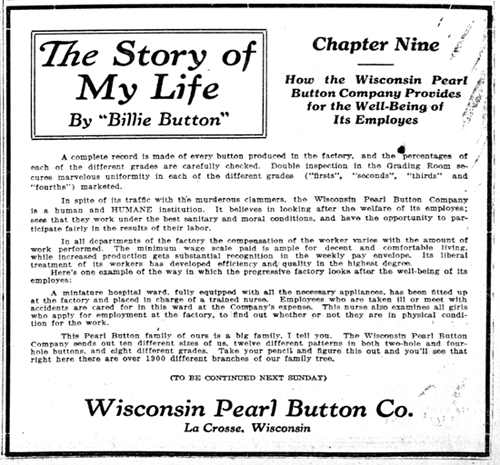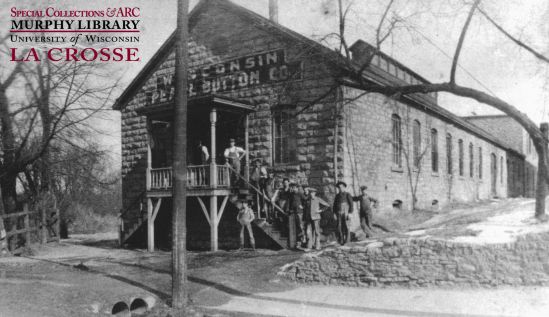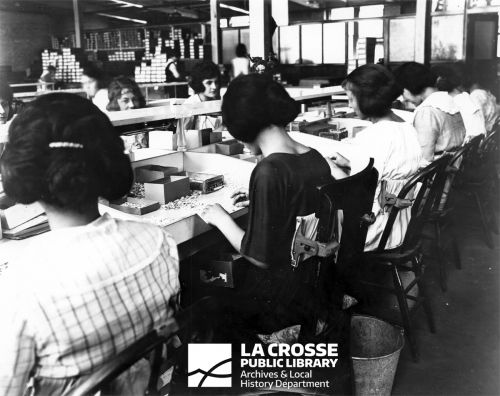
"Billie Button" and the Wisconsin Pearl Button Company
(written by Johnathon Jaeger, Archives intern)

The logo for “The Story of My Life by ‘Billie Button.’” Scan is courtesy of the UWL Murphy Library Special Collections & Area Research Center, where an original pamphlet is held. The La Crosse Public Library Archives also has a copy of the booklet. The full title is "Made in America: Descriptive Story of a Purely American Industry...." first published in 1914.
The story of Billie Button was first published as a pamphlet by the Wisconsin Pearl Button works around 1914 and was later published in the La Crosse Tribune and Leader-Press in 1916 and again across eleven weeks in 1918.

In 1918, Chapter Nine was printed on June 2, page 11. Today, Wisconsin residents can search for the whole series by going the Newspapers.com, which has the La Crosse Tribune digitized and freely available from 1905-1963. Just search “the story of my life by billie button” to view each chapter.
This bizarre advertising campaign consisted of Billie Button, an anthropomorphic button, who explained the life of a Wisconsin Pearl Button Company button, from starting as a clamshell at the bottom of the Mississippi River to being sewed on to a little girl’s dress in Illinois. This advertising campaign worked to reach out possible consumers, improve the public’s view of the company, and to reach out to potential workers.

Photo of the exterior of the Wisconsin Pearl Button Company. This photo was taken from 3rd St. N. looking northeast. Photo is courtesy of the UWL Murphy Library Special Collections & Area Research Center.
The Wisconsin Pearl Button Company first opened in 1900 by Henry Hallauer and it changed hands numerous times. In 1908, it was under the direction of George and John P. Salzer, sons of Rev. John A. Salzer, founder of the Salzer Seed Company. Then, around 1911, it came into the hands of David W. MacWillie, who was president of the company until its demise in 1933. MacWillie led the Wisconsin Pearl Button Company to greatly expanding its operations and opening storehouses in New York and branch factories in Arkansas, Minnesota, and Iowa. The headquarters and main factory was located at 730 3rd Street North.
Photo of the Wisconsin Pearl Button Company in the 1906 Sanborn Fire Insurance Map. This shows the placement of the factory right next to the La Crosse River, right off Third Street North before the bridge over the La Crosse River to the North Side.
The Wisconsin Pearl Button Company quickly became one of the largest employers in La Crosse, employing nearly 225 people in 1902. It was a major employer of women and provided various amenities for their employees, such as a small hospital room for injuries and sickness, a tennis court, dance floor, as well as playing music during work hours, according to William Koch, whose oral history is available at the University of Wisconsin-La Crosse Murphy Library Special Collections and Area Research Center.

Photo of women sorting blanks or buttons at the Wisconsin Pearl Button Company
However, the company was not without its controversy, in fact far from it. On June 1, 1910, the La Crosse Tribune reported that the company had violated child labor laws when hiring a 15-year-old boy. Eleven days later, after a “riot” at the factory because of unfair pay allegations, the weighmaster and foreman, John Studier, was shot by one of the disgruntled workers, Matt Ruesgen. In 1911, strikes by workers that joined the button makers’ union forced MacWillie to pay them fairly for their work.

La Crosse Chronicle 12 June 1910, reporting the murder of John Studier by Matt Ruesgen
In time, the Wisconsin Pearl Button Company was overtaken by the Hawkeye Pearl Button Company in Muscatine, Iowa. After years and years of harvesting shells from various Wisconsin rivers and lakes, there was a massive depletion of fresh-water mussels. This depletion, as well as the invention of plastic, quickly led to the end of the pearl button industry in the Midwest.
If you have any questions about Billie Button, the Wisconsin Pearl Button Company, how to access historic newspapers, or anything else mentioned above, please feel free to contact the La Crosse Public Library Archives and Local History Department at (608) 789-7136 or archives@lacrosselibrary.org.

